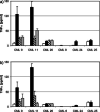The abl/bcr gene product as a novel leukemia-specific antigen: peptides spanning the fusion region of abl/bcr can be recognized by both CD4+ and CD8+ T lymphocytes
- PMID: 12594572
- PMCID: PMC11034279
- DOI: 10.1007/s00262-002-0362-7
The abl/bcr gene product as a novel leukemia-specific antigen: peptides spanning the fusion region of abl/bcr can be recognized by both CD4+ and CD8+ T lymphocytes
Abstract
Chronic myelogenous leukemia (CML) is characterized by a reciprocal translocation leading to the Philadelphia chromosome. Two fusion genes are created by this translocation: bcr/abl and abl/bcr. The fusion regions of both translocation products are unique and strictly limited to leukemia cells, giving rise to potential tumor-specific antigens. Although several studies on the immunogenicity of peptides spanning the bcr/abl fusion region have been reported, little is known about the corresponding reciprocal translocation product abl/bcr. Here we report that synthetic peptides representing the fusion region of the abl/bcr forms a1bb3 and a1bb4 can be specifically recognized by HLA-A2-restricted cytotoxic T lymphocytes from healthy donors. Furthermore, HLA-matched a1bb3-expressing CML cells can be recognized by a1bb3-specific HLA-A2-restricted T cells, indicating natural processing and presentation of abl/bcr protein by leukemia cells. Moreover, a 19-mer peptide encompassing this class I-binding sequence also elicited a1bb3-specific class II-restricted T-cell responses. Thus, both class I- and class II-restricted T-cell responses can be stimulated in healthy donors by abl/bcr peptides in vitro. Because abl/bcr is expressed in the majority of CML patients, it may represent a highly leukemia-specific antigen with potential use in immunotherapy.
Figures





Similar articles
-
Peptides spanning the junctional region of both the abl/bcr and the bcr/abl fusion proteins bind common HLA class I molecules.Leukemia. 2000 Mar;14(3):419-26. doi: 10.1038/sj.leu.2401703. Leukemia. 2000. PMID: 10720136
-
Recognition of BCR-ABL positive leukemic blasts by human CD4+ T cells elicited by primary in vitro immunization with a BCR-ABL breakpoint peptide.Blood. 1996 Nov 1;88(9):3522-7. Blood. 1996. PMID: 8896419
-
HLA class II-restricted antigen presentation of endogenous bcr-abl fusion protein by chronic myelogenous leukemia-derived dendritic cells to CD4(+) T lymphocytes.Blood. 2001 Sep 1;98(5):1498-505. doi: 10.1182/blood.v98.5.1498. Blood. 2001. PMID: 11520800
-
Chronic myeloid leukemia as an immunological target.Am J Hematol. 1997 Jan;54(1):61-7. doi: 10.1002/(sici)1096-8652(199701)54:1<61::aid-ajh9>3.0.co;2-2. Am J Hematol. 1997. PMID: 8980262 Review.
-
BCR-ABL fusion peptides and cytotoxic T cells in chronic myeloid leukaemia.Leuk Lymphoma. 2001 Sep-Oct;42(5):871-80. doi: 10.3109/10428190109097706. Leuk Lymphoma. 2001. PMID: 11697642 Review.
Cited by
-
Immunotherapeutic strategies in chronic myeloid leukemia.Curr Hematol Malig Rep. 2007 May;2(2):89-94. doi: 10.1007/s11899-007-0013-3. Curr Hematol Malig Rep. 2007. PMID: 20425356 Review.
-
Developing strategies in the immunotherapy of leukemias.Cancer Control. 2013 Jan;20(1):49-59. doi: 10.1177/107327481302000108. Cancer Control. 2013. PMID: 23302907 Free PMC article. Review.
-
CD4-positive T-helper cell responses to the PASD1 protein in patients with diffuse large B-cell lymphoma.Haematologica. 2011 Jan;96(1):78-86. doi: 10.3324/haematol.2010.028241. Epub 2010 Sep 17. Haematologica. 2011. PMID: 20851862 Free PMC article.
-
Identification and Targeting of Mutant Peptide Neoantigens in Cancer Immunotherapy.Cancers (Basel). 2021 Aug 23;13(16):4245. doi: 10.3390/cancers13164245. Cancers (Basel). 2021. PMID: 34439399 Free PMC article. Review.
-
T cell-mediated graft-versus-leukemia reactions after allogeneic stem cell transplantation.Cancer Immunol Immunother. 2005 Nov;54(11):1043-58. doi: 10.1007/s00262-005-0681-6. Epub 2005 May 11. Cancer Immunol Immunother. 2005. PMID: 15887014 Free PMC article. Review.
Publication types
MeSH terms
Substances
LinkOut - more resources
Full Text Sources
Other Literature Sources
Medical
Research Materials
Miscellaneous

